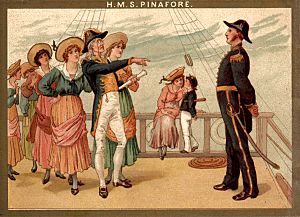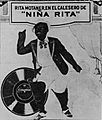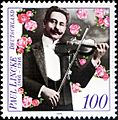Operetta facts for kids
Operetta is a type of musical show that became popular in the 19th century. It's often called "light opera" because it's usually fun, funny, and not too serious. Unlike a traditional opera, where almost everything is sung, an operetta has a lot of spoken parts. It mixes these spoken lines with catchy songs and lively dances.
Similar kinds of musical entertainment existed before operetta. For example, in Germany, there was a tradition called Singspiel, which also combined singing with spoken dialogue. A famous example is Mozart's The Magic Flute. The operetta style first started in France and quickly spread to Austria and other countries. It remained very popular until the middle of the 20th century, when it slowly changed into what we now call musical comedy.
Contents
The Birth of Operetta
The composer Jacques Offenbach is often seen as the person who really created the operetta. Before him, a type of French opera called opéra comique had become quite long and serious. People wanted something shorter, more humorous, and entertaining.
Offenbach's Influence
Offenbach began writing operettas in the 1850s in Paris. His shows were a big hit! In England, similar works were often called "comic operas."
The Rise of Viennese Operetta
Soon, Johann Strauss II became very popular in Vienna. He was already famous for his ballroom dance music. When he started writing for the theatre, he quickly became a friendly rival to Offenbach. Offenbach's operettas were already well-known in Vienna. Strauss's operetta Die Fledermaus (which means "The Bat") has been performed more than any other operetta ever! In Spain, a similar musical style called Zarzuela was also very popular.
People Behind Operettas
Many talented people worked together to create and perform operettas. The performers often had to be great singers and excellent actors at the same time.
Famous Composers
Several well-known composers wrote operettas, alongside their other musical works. These included Georges Bizet, Chabrier, and Léo Delibes. In England, the famous works by Gilbert and Sullivan were a unique English version of operetta.
Popular Shows and Composers
One of the most famous operettas of all time is Die Lustige Witwe (The Merry Widow) by Franz Lehár. It first appeared in Vienna in 1905 and was a huge success. Lehár wrote many other operettas too. Franz von Suppé is another composer known for his operettas in the Austrian style. A well-known Romanian operetta is Crai nou (New Moon) by Ciprian Porumbescu.
Operetta's Changing Style
In the early 20th century, French operettas became less popular. People became more interested in the lively Viennese operettas. After World War I, the city of Berlin became the main center for German operetta.
By the middle of the 20th century, many composers were writing light operas that used music inspired by American dance bands. These new shows were no longer called "operettas." The word "operetta" continued to be used for light operas that sounded more like traditional music from central Europe.
Images for kids
-
The audience at the Théâtre des Bouffes-Parisiens, where Jacques Offenbach's operettas first became popular (1860).
-
A Columbia Records advertisement for a recording of Rita Montaner in a show called La Calesera, which is a Spanish operetta (zarzuela).
-
Cover page of Boccaccio, oder Der Prinz von Palermo (Boccaccio, or the Prince of Palermo) by Franz von Suppé from 1879. This is an example of an early Viennese operetta.
-
Johann Strauss II, a famous operetta composer.
-
A poster for Die lustige Witwe (The Merry Widow) by Franz Lehár.
-
Paul Lincke, known as the father of the Berlin operetta.
See also
 In Spanish: Opereta para niños
In Spanish: Opereta para niños








